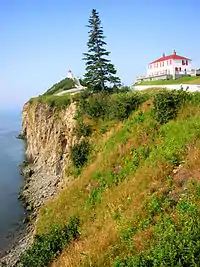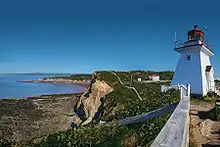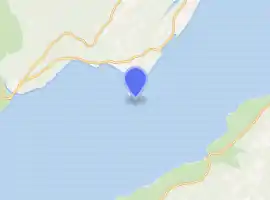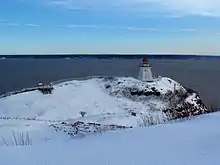Cape Enrage
Cape Enrage is the name given to the southern tip of Barn Marsh Island, an island located in Albert County, New Brunswick, Canada, roughly half way along the coastline between the villages of Riverside-Albert and Alma at the eastern entrance to Fundy National Park.

Accessible from Route 915, the island itself is surrounded by jagged sea cliffs that are often more than 50 metres (145 ft) high, and is separated from the mainland by a narrow tidal creek.
Cape Enrage derives its name from the large reef that extends south into Chignecto Bay, which causes the water off the point to become extremely violent, particularly at half tide when the reef is partially exposed and the water is moving quickly.
Cape Enrage Lighthouse
 Cape Enrage Lighthouse in panorama | |
 New Brunswick | |

| |
| Location | Barn Marsh Island County Albert Canada |
|---|---|
| Coordinates | 45.593969°N 64.779956°W |
| Year first constructed | 1838 (first) |
| Year first lit | 1870 (current) |
| Deactivated | 1870 (first) |
| Foundation | concrete base |
| Construction | wooden tower |
| Tower shape | square frustum tower with balcony and lantern |
| Markings / pattern | white tower, red lantern and rail |
| Tower height | 9 metres (30 ft) |
| Focal height | 38 metres (125 ft) |
| Range | 10 nautical miles (19 km; 12 mi)[1] |
| Characteristic | Fl G 6s. |
| Fog signal | 3 blasts every 60s. |
| Admiralty number | H4060 |
| CHS number | CCG 157 |
| NGA number | 11064 |
| ARLHS number | CAN-096 |
| Managing agent | Cape Enragé Adventure Centre[2] |
The first lighthouse in the Upper Bay of Fundy, started in 1838 and completed in 1840, is located at Cape Enrage (see List of lighthouses in New Brunswick). It has been automated and unmanned since the 1980s, but it has recently become a popular tourist destination, as a result of a concentrated effort by local students to renovate the property and run it as a summer project. Frommer's travel guide lists it as one of the 'Best Views in Canada.'[3]

Acadian sailors made early mention of 'Cap Enragé,' and after the Acadian expulsion, British settlers anglicised the name to Cape Enrage. During the 1820 and 30s, Cape Enrage contested as the location of the first lighthouse in Chignecto Bay, and the site was selected as the preferred location. The lighthouse was completed in 1840.[4] A variety of boathouses and temporary lighthouse keeper's houses were built over the next decades, but were frequently damaged or destroyed in the region's numerous storms and harsh winters. The lighthouse itself was heavily damaged in one storm in the 1840s, and was extensively repaired. The current lighthouse keeper's house dates from 1952.
The lighthouse was automated in the late 1980s by the Canadian Coast Guard, and the last lighthouse keeper, Noel Justison, left the property in 1988. The property quickly began to suffer from neglect and vandalism, and by 1993 all of the buildings except the lighthouse were scheduled for demolition by the government. However, in 1993 a small group of high school students from Moncton, under the supervision of Dennison Tate, their physics teacher, began a restoration project at the site, renovating all of the buildings and slowly turning the site into a tourist destination. From 1993 to 2009 Cape Enrage Interpretive Centre, a not-for-profit, student-run organisation, maintained the property and the students also offered climbing, rappelling, and kayaking in the summer months through the for-profit business, Cape Enrage Adventures. In 1995 the keepers house transferred from the Canadian Coast Guard to Province of New Brunswick along with 4+ acres of land. In the summer of 2004 the Canadian Coast Guard formally transferred ownership of the lighthouse to Cape Enrage Adventures and Cape Enrage Interpretive Centre.
References
- List of Lights, Pub. 110: Greenland, The East Coasts of North and South America (Excluding Continental U.S.A. Except the East Coast of Florida) and the West Indies (PDF). List of Lights. United States National Geospatial-Intelligence Agency. 2015.
- Rowlett, Russ. "Lighthouses of Southern New Brunswick". The Lighthouse Directory. University of North Carolina at Chapel Hill. Retrieved December 28, 2015.
- 'Best Views in Canada'
- For a summary of the debate, see for example, Jeffrey P. Ward (2009) Head of the Bay: A History of the Maringouin Peninsula, Bay of Fundy, Canada, Sackville: Tantramar Heritage Trust, p. 96. The competing locations were Grindstone Island and Apple River.
External links
| Wikimedia Commons has media related to Cape Enrage. |